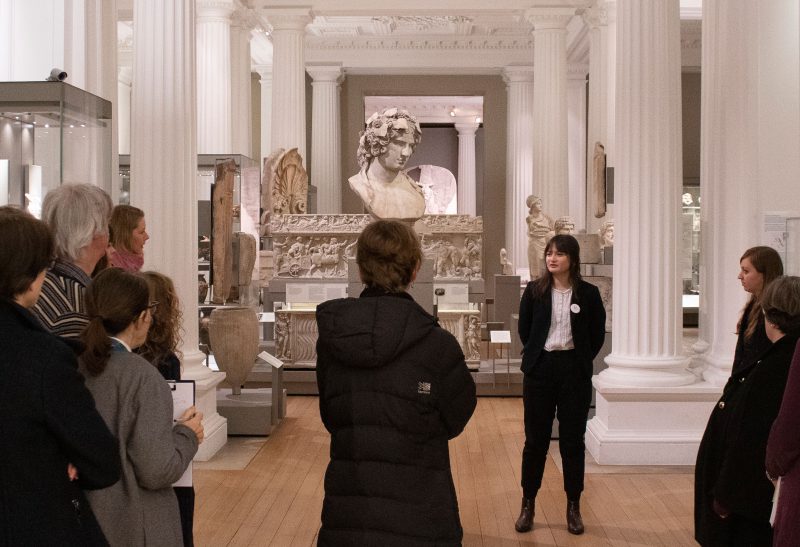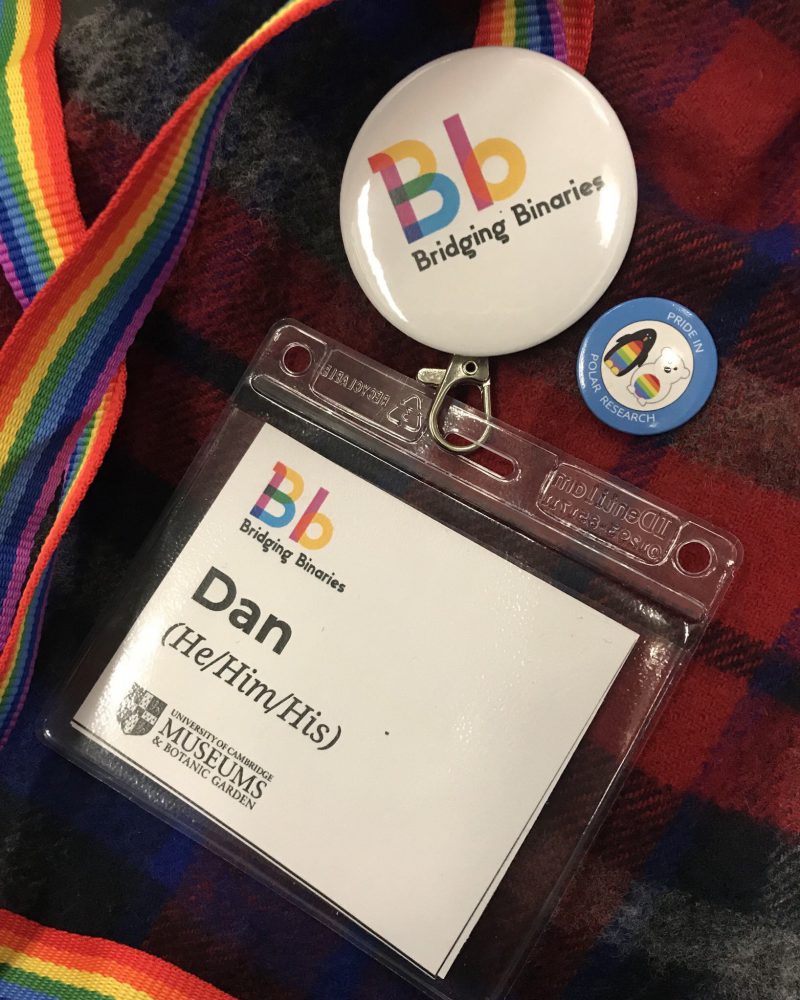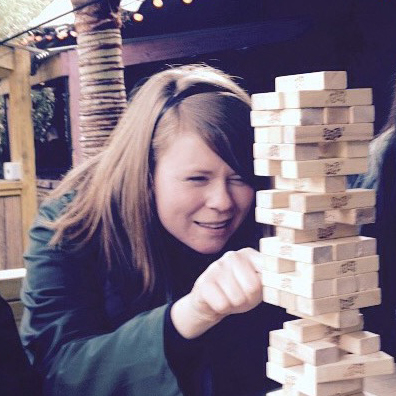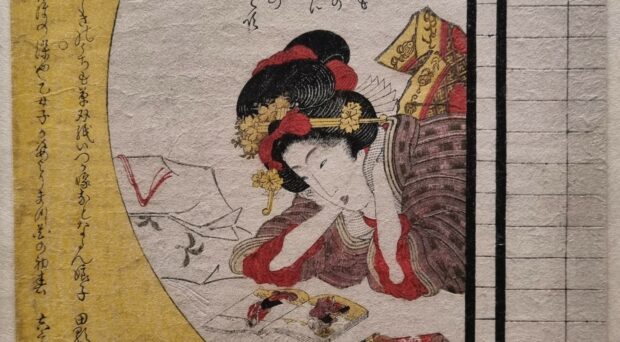In December 2018, the University of Cambridge Museums (UCM) launched a pilot series of volunteer-led LGBTQ+ tours: Bridging Binaries. Forty tours, four museums and a lot of press coverage later, it’s time to look back on the pilot and plot the next steps.
The project saw a team of dedicated volunteers develop their own LGBTQ+ tours in the Museum of Zoology, Museum of Classical Archaeology, Fitzwilliam Museum and Polar Museum, using research by consultant Dan Vo. We caught up with Jenny Bull, UCM Engagement Coordinator, and Niki Hughes, UCM Opening Doors Project Coordinator, to find out how it all went.

Jen and Niki, you’ve been busy behind the scenes facilitating the project. What makes Bridging Binaries such a significant step for the UCM?
Jen: Firstly, it’s important that the project has helped the museums to bring out untold, marginalised stories in their collections.
Niki: And highlighting that the stories are there. In the past, museums have presented their collections in ways that were socially-acceptable to the times, but were entirely constructed. This project is a way of delving into the collections and seeing what else there is, and what has been hidden. There’s so much that has been actively hidden. Take the example of the Emperor Penguin, which is part of the Museum of Zoology tour. The Victorian naturalist who witnessed the penguin’s annual breeding cycle for the first time also identified same sex behaviour in the penguins. He was so shocked by it that he wrote it up in Ancient Greek not English, so that only the learned would only be able to read about it.
Bridging Binaries tour guide Tim Drummond tells the story:
Did anything unexpected happen?
Niki: For me, what was relatively unexpected was the success we had with the recruitment of the volunteers. Some of them weren’t museum people at all, and came to us from a completely different background and interest. It’s been brilliant, because it has opened up whole new communities – not just the LGBTQ+ community, but also non-visitors – to the UCM, and vice versa. One of volunteers, who didn’t have much interest in museums before the project, has even gone on to take a job at the Fitzwilliam, which for me is two thumbs up!

Jen: For me, it’s the level of enthusiasm for the project as a whole. I knew people were going to find it interesting and important, but the level of reaction from our audiences, including the University, and the wider world, shows that people want these kind of stories and projects to happen.
Jen is being modest: the tours have been featured in The Times, The New York Times, The Art Newspaper, The Cambridge Independent and elsewhere.

Feedback from visitors has been very positive.
Jen: Definitely. Visitors told us how important they thought the project was because they are from LGBTQ+ communities, and there was lots of enthusiasm for what people had learned. Other feedback was around wanting the project ot continue and for the research to permeate the museum properly – not just as tours, which are ephemeral compared to displays.
‘I think these tours are brilliant and much needed. They offer visibility and representation to LGBTQ+ people which has been missing from Britain’s museums for too long. … I hope very much that they lead to greater consideration being given to queer people and themes in Cambridge’s Museums on a more day to day basis (e.g. exhibitions, labelling, DIY trails)’ – Tour attendee
‘I liked all the information from the tour a great deal and feel that knowing it would impact my future visits to the museum. I also thought that the thinking behind how the information was given was very thoughtful, and as a queer non-binary person I felt like I was being talked to in a way that included me rather than ‘talked at’. … I [think] the tour would be interesting to people that both identify as LGBT but also that [don’t]… for those that do it would make them feel more welcome in Museum spaces…for those that don’t… [it’s] an opportunity to expand thinking. Particularly in regards to how discrimination and exclusion can lead to faulty or inaccurate research.’ – Tour attendee
Had the pleasure of attending a #BridgingBinaries Tour of the Polar Museum (w/ great tour guide Leah) – much more than “gay penguins”! Engraving bones during 19thC #Arctic explorations was apparently encouraged to limit masturbation pic.twitter.com/jCN6A03wYO
— Nannageddon (@nannakaalund) March 11, 2019
We know anecdotally that for some visitors their tour had a very profound, emotional impact, with at least one really significant life decision made.

Also significant, I think, is that it’s really brought in a new audience to the UCM. 37% of all tour attendees at the four museums were first time visitors, and that was even higher for the Polar Museum and the Museum of Classical Archaeology.
‘It was great, to my shame I had never been to the Polar Museum before, and it inspirited me to visit again. I really enjoyed the queer focus on some of the objects.’ – Tour attendee
‘I’d love to see these kind of tours, especially focussing on critical issues such as colonialism and LGBTQ+ in other museums too!’ – Tour attendee
There’s a huge appetite for this kind of programming.
Niki: Yes, and I think going forward it’s about making sure this is woven into everything the museum does – not just tours, but taking LGBTQ+ history into consideration when developing new displays. I always say to people when they ask about the tours that they should start with the Museum of Zoology one, because it sets the scene. It says “this is our world and where we live, and what happens there – there’s nothing more natural.” I think it’s wonderful.
How did you share the workload?
Jen: We put together the project plan together, consulting with our local LGBTQ+ network, the Encompass Network, who came in and contributed to our training. We also consulted with museums and the University and the museums before we started.
Niki: My role was on the volunteer side – personnel, as it were. I put the word out about the opportunities, recruited the volunteers and provided training, which was good fun. We delivered a mix of two UCM-wide training programmes, Warm Welcome and tour guide training, as a package. Then I also have a pastoral role, making sure that the volunteers are happy and comfortable.
Jen: I also supported the training days, and I guess did the more logistical side of the people management. So I set up contact days with the volunteers in the lead-up to the tours, liaised with Cambridge Live, who operated our ticketing, and set the rotas, making sure that everyone was in the right place at the right time. We also both helped all of the volunteers test their tours before the pilots happened, and, between us, were present for all the pilot runs across the museums.
We’re live talking to Colin about leading LGBTQ+ tours @classarch – ask your questions! https://t.co/V4yrHV3L7R
— Cambridge Museums (@CamUnivMuseums) February 18, 2019
Above: Tour guide Colin Clews gives us a snippet of his Museum of Classical Archaeology tour on Twitter.
Dan Vo, who coordinates LGBTQ+ tours at the V&A, has been a crucial partner in the project – as you discuss in your kick-off blog – and it feels really significant that it has been his and the museums’ research that the tours are based on. We’re part of a massive research institution, but research questions are so often shaped from within, not by the community. The museums themselves have been a bridging space in this project in that respect and it feels quite radical.
Niki: It’s been so important working with Dan as he’s the expert in his field – we’re not. We’re allies. Initially, I was quite nervous about that, and that I don’t identify with queer – how can I fit in with this, when these aren’t my stories to tell? Actually, the project has made me feel very proud to be an ally.

Jen: Dan has a really clear approach to researching the tours and queering collections. It could be that the focus is something created by someone from the LGBTQ+ community, or the subject or context is related to LGBTQ+ history, or something which the LGBTQ+ community has made part of its story. Although he worked closely with museum collections colleagues, it’s not an approach that would necessarily have been thought of internally, as it’s shaped by his experience and knowledge of the community. And then the tour guides themselves make a further choice what they think are the stories that resonate with them.
And we’ve learned a lot. It shows how much there is to learn. The fact that some of these stories have been actively hidden reveals how biased people can be and how biased history is.
‘I liked seeing stories about objects that I otherwise wouldn’t have realised had an LGBTQ+ relevance. Also, it helped me to see more of the museum.’ – Tour attendee
‘It brought out the humanity associated with the objects and the way that even an object like an egg can reflect the opinions and prejudices of its collector.’ – Tour attendee

The volunteers were very much involved in shaping the marketing approach, choosing the title and approving the designs. Do you think the way we’ve marketed the tours has helped reach those first-time visitors?
Niki: Well, the posters are fabulous. The movement on social media has been pretty epic, and it’s been taken up and shared by other people. It’s been monitored by the community online. Any trolling has been met with push back from the community, without us stepping in.
Jen: Yes, social media has been really important. 41% of attendees heard about the project on Facebook.

What’s next?
Both: More tours!
Jen: This month (May) Dan and Ellie Armstrong, who is helping him with the second wave, met staff at the Whipple Museum of the History of Science, Museum of Archaeology and Anthropology and Sedgwick Museum of Earth Sciences for a kick-off, and will begin new research. We’re not sure yet whether or not tours will happen in all those places because of logistical reasons, but we wanted to ensure we had a real spread of content. We’ll have the content ready in October and will recruit a new wave of volunteers, ahead of new tours in February 2020.
Niki: Last year we gave ourselves a very large lead time, because it was new and fresh. This year we’ll make sure we tie in with the academic year to ensure that students can be involved. The training is there and ready to roll. We just need to figure out how many more people we need, taking into consideration that there will always be drop out.

Jen: Next steps in the project we’ll be seeing how the existing monthly tours go. There is a big audience for them, but as our colleagues in the museums are now taking on some of the logistics we need to make sure it’s sustainable. We’d also like to make sure we fully evaluate the volunteer experience – they are, after all, at the heart of the project and we are so grateful to them for all they have done!
‘It has been really great to work on the project with people outside of the university and bridge the gap between town/gown. Has also been really great to meet people on the tours who are so interested in what I’m talking about/ are very grateful for our work.’ – Feedback from Bridging Binaries volunteer tour guide
We are hugely grateful to all our colleagues for their support, and in particular to Jack Ashby, Anastasia Christophilopoulou, Charlotte Connelly, Rachel Sinfield, Miranda Stearn and Susanne Turner, and also to the Encompass Network, for their guidance and support.
Tickets are available for tours in June and July! Book via our website.









